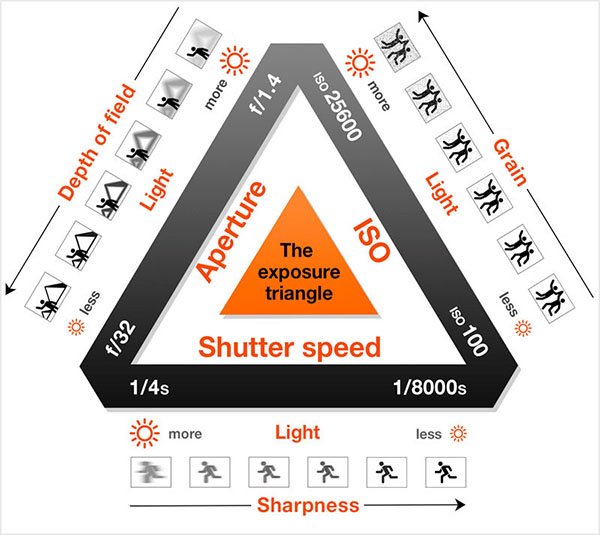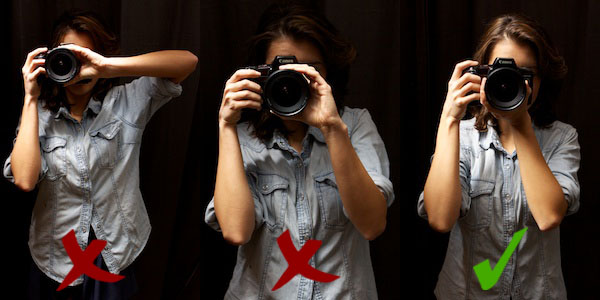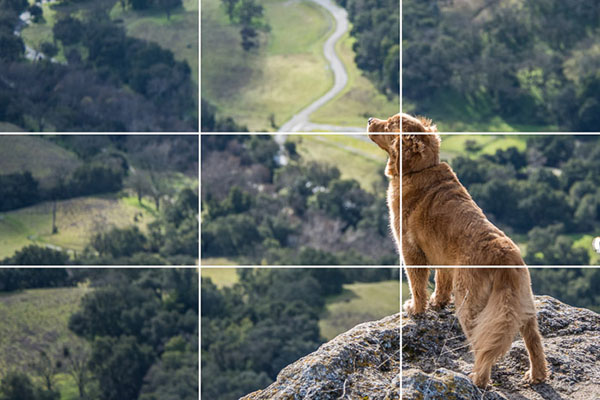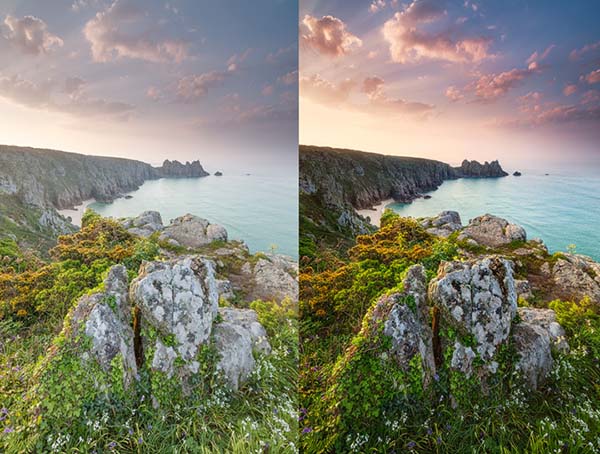The most basic things for new photographers
1. A set of three metering modes
Photography, the simplest understanding is working with light. Most newcomers to the art industry argue that a good camera can produce great photos. However, the magic lies in the light.
Therefore, it is imperative that you understand the metering triad in photography. This is the basic and also the most important in this area.
When taking a photo, the shutter in the camera opens and light is collected into the lens. Camera sensor meets the light, the image will be created. There are three factors that determine how much light enters the lens and what the image will look like:
- Aperture : This is the aperture of the lens, often referred to as f-stops (e.g. f / 2, f / 5, f / 11, .). The smaller the number, the larger the aperture. The larger the aperture, the more light enters. Aperture also affects the depth of image.
- Shutter speed (often referred to as speed): Shutter time is open, usually measured in seconds (for example 1 / 200s, 1 / 60s, 5s, .). The slower the shutter speed, the more light is allowed in. Shutter speeds often affect the sensitivity of actions (for example, fast shutter speeds can capture extremely fast actions, slow speeds can cause exposure).
- ISO : This is a measure of the sensitivity of an image sensor to light, measured in ISO units (e.g. 100 ISO, 400 ISO, 6400 ISO, .). High ISO allows you to take pictures in a dark room or in low light conditions, but in exchange for a lot of noise.
To take a good picture, you must know the combination of the three factors. This is not an easy skill to learn, it takes a lot of shooting to have experience with each type of lighting environment.
 Artwork triangles metering
Artwork triangles metering 2. How to hold the camera
The next thing that a beginner should take note of is how to hold the camera properly. 'Standard' here means holding the camera so as to avoid shaking as much as possible.
When the shutter button is pressed, the shutter opens to the sensor to receive light. Any small move while the shutter is open will produce a blurry photo. Not moving means not shaking the device.
 How to hold the camera
How to hold the camera When taking photos in low light, long exposures, or taking photos with telephoto lenses, you should use a tripod.
3. The 3-part rule
Just by looking at the picture, you can know where is the professional photographer, what is the amateur. The difference is in the arrangement of the image. Amateur people often do not have much sense of composition and composition is the soul of a beautiful picture.
Composition is the arrangement of details in an image. If you don't care about the composition and still get great shots, this is a complete coincidence. Understanding the composition of photos will help you take great photos with every object, place, and situation.
Typically, the best image layout is divided into 3 sections vertically and horizontally. All photographers use this technique. The three-part rule is a simple and effective way of dividing the composition, helping beginners to form a habit of dividing the composition in detail before holding the camera up for shooting.
 3-part rule in photography
3-part rule in photography 4. Change the shooting angle
Yes, this is something you've heard about being boring - change your perspective when taking photos. However, to do this is certainly not easy. Try changing the following:
- Change in altitude (e.g. getting closer or further to the ground)
- Change angle (stand straight or shoot from an angle)
- Change the distance (stand closer or farther)
Try combining all three methods above. You will be surprised to see how much the picture changes.
5. Post-production is very important
Post-editing with an image is often understood as changing the original image by adjusting colors, lighting or adding filters to the original image. This misunderstanding has caused many photographers to never post-edit photos, because they want to have the most natural picture.
Every camera has post-editing whether you like it or not. The original data of the image is in RAW format, but the image you view on the LCD screen (or on the phone) has been converted to another format.
 Post-editing makes photos look richer
Post-editing makes photos look richer Not all post production requires Photoshop. Sometimes they are over-modified or intentionally modified for some purpose. Anyway, you should do post-production after taking pictures. Do not underestimate this important skill.
6. Shoot often, shoot everything
Has iron grinding makes perfect. This is definitely the only way you can improve. No matter how many youtube channels you watch, how many photography courses you have, if you don't practice shooting regularly, you won't be able to go very far. Shoot anything, no matter how bright or dark, just take the time, get the camera out to shoot.
You should read it
- Download 1998 Cam, an old-fashioned animation and video capture app for iPhone, is now free
- Top 6 film photography applications for iPhone
- All you need to know about film photography, an artistic hobby
- 9 basic rules of composition in photography
- How to use the FIMO application to take photos of classic film?
- Download HD Camera Pro, a 94,000 VND professional photography app, which is free
- How to take a 1998 film effect image on iPhone
- Should you choose a digital camera?
- Turn on the secret feature of iPhone Camera on iOS 11
- Pocket basic terms in photography - P1
- 'Beginner lessons' take landscape photos for new ghosts
- Basic dangerous errors in Rules of Survival
May be interested

Homemade CCTV from the old smartphone

Instructions for installing Camera Ezviz on the phone

Instructions for installing Hikvision recorder via network

6 common errors on the camera and how to fix them

Differences between two types of DSLR and Mirrorless cameras

Let iPhone camera always start with Portrait mode






 7 commands to manipulate the most basic files and folders everyone must know
7 commands to manipulate the most basic files and folders everyone must know Basic knowledge of SEO
Basic knowledge of SEO 9 basic rules of composition in photography
9 basic rules of composition in photography Things to know about USB 3.0
Things to know about USB 3.0 Collection of beautiful nature photos taken by Dronestagram
Collection of beautiful nature photos taken by Dronestagram Take a look at the same location, how the two pictures were taken by different professional and amateur photographers!
Take a look at the same location, how the two pictures were taken by different professional and amateur photographers!